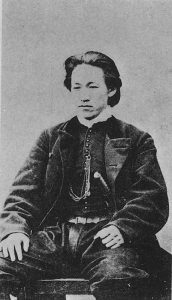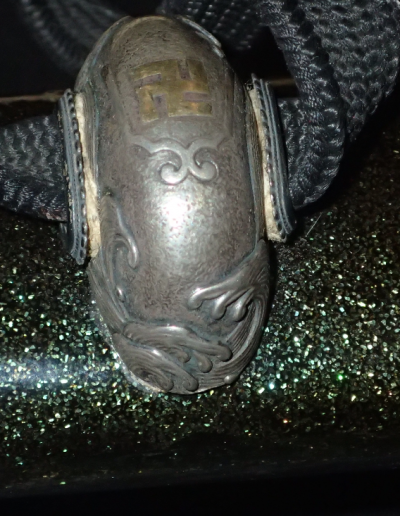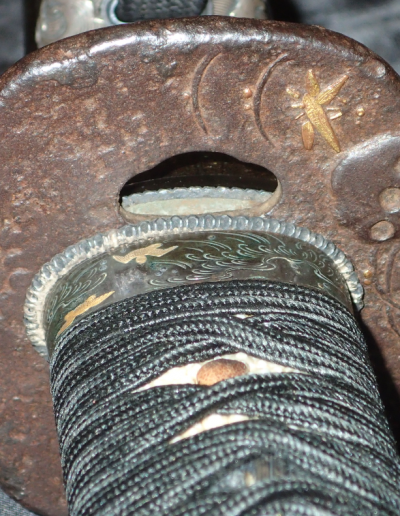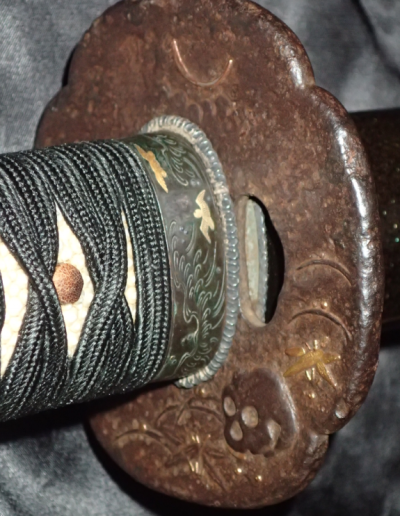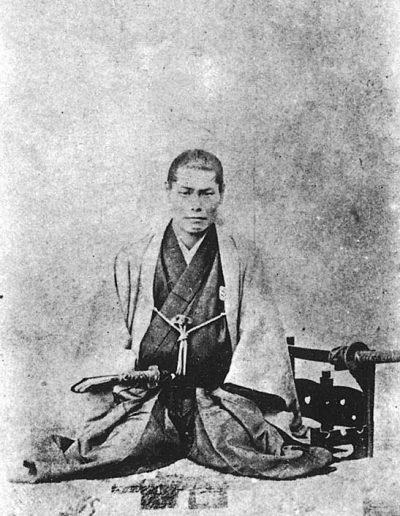Here we have an incredibly interesting and historically important sword owned by Oishi Kuwajiro member of the Shisengumi, Kuwajiro was a known and feared assassin of the Shinsengumi Ôishi was called “Hitokiri Kuwajiro” because of his involvement in many assassinations by the Shisengumi . Oishi Kuwajiro was known as one of the The Four Hitokiri of the Bakumatsu (幕末四大人斬り Bakumatsu Yondai Hitokiri) was a term given to four Samurai during the Bakumatsu era in Japanese history. The word hitokiri literally means “manslayer” or “man cutter,” as the kanji 人 means person, while 斬 can alternatively mean slay or cut. Oishi was known to have been involved in many historical incidents and also carried out unknown numbers of assasinations he was also accused of killing Sakamoto Ryoma, He lived a short but eventful life, In March 1868, he fled the Shinsengumi and tried to join the Satsuma han troops. But he was captured and executed on the charge of murder of Ito Kashitaro in 1870.
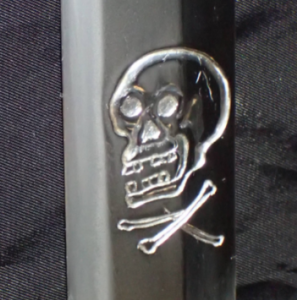
This sword has only come to light recently from the descendants of Oishi Kuwajiro in what we will describe as a well used condition, Its since been restored and certified by the NBTHK, The sword is mounted in Shirasaya and also comes with interesting koshirae with the Nozarashi theme on the saya lacquered in crushed shell with makie of skeleton, Tsuba is Iron with skull / Nozarashi motif. Fuchi kashira are shakudo with wave bird and moon motif , The Menuki are in the form of bones in silver. The blade is a well forged mumei Shinshinto Naminohira with a wide Suguha Hamon ,Horimono of Skull and Crescent Moon on the ura.The blade is thick and heavy typical Shinshinto style , The Nakago bears an interesting gold / Kin Zogan inscription which reads Ningen Mukotsu Shingengumi Ōishi Kuwajirō Kore O haku (人間無骨新撰組大石鍬次郎帯之) ‒ “Humans have no bones, worn by the Shinsengumi Ōishi Kuwajirō”
NBTHK Hozon Certificate Translation
KANTEI-SHO (鑑定書) – APPRAISAL NBTHK
Katana, unsigned: Shinshintō Naminohira (新々波平)
No 3021478
Bears the kinzōgan inscription: Ningen Mukotsu Shingengumi Ōishi Kuwajirō Kore O haku (人間無骨新撰組大石鍬次郎帯之) ‒ “Humans have no
bones, worn by the Shinsengumi Ōishi Kuwajirō”
Nagasa ~ 64.4 cm
According to the result of the shinsa committee of our society, we judge this work as authentic and rank it as Hozon Tōken.
August 26, 2019
[Foundation] Nihon Bijutsu Tōken Hozon Kyōkai, NBTHK (日本美術刀劍保存協會)

About Ōishi Kuwajirō (大石鍬次郎)
Ōishi Kuwajirō (大石鍬次郎), lived from Tenpō nine (天保, 1838) to the tenth day of the tenth month of Meiji three (明治, 1870). Shinsengumi member (function of troop inspector) of the Bakumatsu era. Official first name Morichika (守親). From the Genji clan (lineage of Seiwa-Genji Yoshinaka, 清和源氏義仲).
Career
Born in Tenpō nine (天保, 1838) as eldest son of Ōishi Sutejirō (大石捨次郎) who was a close guard of the renowned Hitotsubashi (一橋) family, one of the three branches of the Tokugawa clans. His initial first name was Kinnosuke (金之助).
Due to a conflict (it is assumed it was about an issue with a women), he left his family and lived with a carpenter from Hino (日野) in Musashi province. This carpenter was an acquantaince of the village head Satō Hikogorō (佐藤彦五郎, 1827-1902) and it was through this connection that Ōishi was able to train at Hikogorō’s fencing dōjō.
Ōshi joined the Shinsengumi when Kondō Isami (近藤勇, 1834-1868) was recruiting in Edo from the ninth to the tenth month of Genji one (元治, 1864) after the Ikedaya Incident had taken place earlier in the sixth month of that year. As he was mainly carrying out assassinations, he was feared as “Ōshi the Assassin.” Ōishi was practicing the Ono-ha Ittō-ryū (小野派一刀流) of swords- manship but also studied the Tennen Rishin-ryū (天然理心流) that was followed by Kondō Isami. The Shidankai Sokki Roku (史談会速記録), a Taishō-era (大正, 1912-1926) record of statements from then aging contemporary wittnesses, mentions on several occasions Ōshi being an as apt swordsman as the famous Okita Sōji (沖田総司, 1842-1868).
According to the Torishirabe Nikki (取調日記) records of Shinsengumi member Yamazaki Susumu’s (山﨑丞, 1833-1868), Ōshi was a member of the first unit of the Shinsengumi lead by Okita Sōji at least by the fifth month of Keiō one (慶応, 1865).
In the ninth month of Keiō two (1866), Ōshi was deployed as commander of a unit of ten to an issue which became known as the Sanjō Seisatsu Incident. When the Shinsengumi became assimilated into the Bakufu troops in the sixth month of Keiō three (1867), Ōshi became troop inspector. In the eleventh month of that year, Ōshi assassinated Itō Kashitarō (伊東甲子太郎, 1835-1867) in the Aburanokōji Incident. In the twelfth month, Ōshi, Saitō Hajime (斎藤一, 1844- 1915) and others were ordered to protect the Kishū samurai Miura Kyūtarō (三浦休太郎, 1829- 1910) in the Tenmaya Incident.
When the Bakufu retreated from the Battle of Toba-Fushimi in the first month of Keiō four (1868), the Shinsengumi withdrew to Edo where Kondō formed a troop named Kōyō Chinbu Tai to follow the Bakufu’s order to assist pacifying Kai province. The troop of which Ōshi was a member was sent to Kai where it was defeated in the third month of that year and disbanded. After that, Ōshi was hiding in Edo with his wife and children but was captured in the twelfth month being betrayed by a friend and former Shinsengumi member, Mitsui Ushinosuke (三井丑之助). According to a tradition, Ōshi, troubled with life, approached former Shinsengumi member Kanō Washio (加納鷲雄, 1839-1902) who had become a member of the government forces under the Itō Faction and begged him to let him go, but without success. However, there is no historic record which would back this tradition and it is contradicted by the later testimony of Kanō’s comrade Abe Jūrō (阿部十郎, 1837-1907).
Ōishi was accused of Sakamoto Ryōma’s (坂本龍馬, 1836-1867) assassination in the Ōmiya Incident and confessed even if there had not been a thorough investigation. Later, however, he retracted his confession and said the job was carried out by the Tokugawa special forces Mimawarigumi. In any case, Ōshi was beheaded on the tenth day of the tenth month of Meiji three (明治, 1870) (November 3, 1870, in the Western calender) for the assassination of Itō Kashitarō, He was 32 years old at that time.
Due to fear of interrogation, Ōishi’s son and heir Raitarō (雷太郎) changed his name to Honma Utakichi (本間歌吉) and it is said that he later ran a shop for tortoise shell produces in the Inarichō (稲荷町) neighborhood of the Shitaya district of Tōkyō.

Notes on Transfer from family, Name and Address have not been published in respect and privacy of the family
This sword was owned by my great-grandfather Ōishi Kuwajirō and was since handed down within our family. As we are no longer able to properly maintain the sword, we hand it over to Mr. ……
On a lucky day in March of 2019
ADDRESS ……….
NAME ….. ……. [Seal]
Who were the Shinsegumi?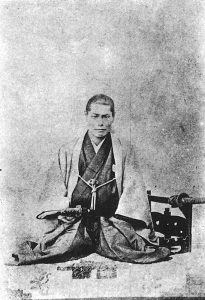
The Shinsengumi (新撰組 or 新選組) were an small elite group of swordsmen commissioned by the Tokugawa Shogunate in 1863 as a special police force to counter Pro-Imperial and anti-shogunate subversion in Kyōto. The Shinsengumi, lit. “newly established corps”, was first called Rōshigumi (浪士組), as most of its members were Ronin , Masterless Samurai recruited in Edo (modern-day Tōkyō) in 1863 and sent to Kyōto to protect the Shogun who was visiting the city at that time.The Shinsengumi consisted of around 400 members.
One of its leaders though, Kiyokawa Hachirō (清河八郎, 1830-1863) was recalled to Edo for expressing Pro-Imperial sentiments. The remaining thirteen members of the Rōshigumi under Serizawa Kamo (芹沢鴨, 1826-1863) became the founding members of the Shinsengumi. Serizawa was murdered in an internal struggle, and Kondō Isami (近藤 勇, 1834-1868) and Hijikata Toshizō (土方歳三, 1835-1869) emerged as the new leaders. Based in Mibu in Kyōto, the Shinsengumi acted under orders from the Kyōto Shugoshoku (京都守護職, Office of Kyōto Protector), a shogunal office in the period from 1862 to 1868, which was held by Matsudaira Katamori of Aizu for most of its existence and served to keep peace in the city.
The group was involved in the famous massacre at the Ikedaya Inn in 1864 and the defence of the Imperial Palace in the Hamaguri Gomon Incident. Even after the Meiji Restoration the Shinsengumi remained loyal to the shōgun, fighting against the Satsuma-Chōshū Alliance in the Boshin War.Toshizō Hijikata and his men died in the Battle of Hakodate in June 1869 against the Imperial forces.
Ikedaya Incident 
The Ikedaya Incident (池田屋事件 Ikedaya jiken) was an armed encounter in July 1864 between the Shinsengumi, at the Ikedaya Inn, located in the outskirts of Kyōto. After extremist forces of the Choshu Domain had tried to take control of the imperial palace and were expelled from the capital, moderate forces from the Satsuma and the Aizu domains who advocated reconciliation between the imperial court and the shogunate took over politics. In the wake of their expulsion, Chōshū elements sought to regain control of Kyōto and plotted the assassination of Tokugawa leaders and pro-shogunate court nobles. On the night of July 8, 1864, the Shinsengumi under Kondō Isami attacked a gathering of these activists at the Ikedaya Inn. Eight of them were killed and four seriously wounded. Over twenty anti-shogunate activists were arrested, many of them from Chōshū.
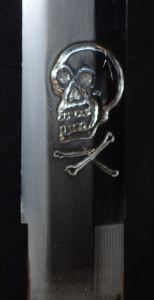
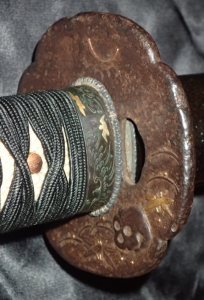
The Bakumatsu Period
The (幕末 bakumatsu, a compound word, translatable as “the end” or matsu of the military government or baku, which abbreviates bakufu, in turn literally meaning “tent-government”) refers to the final years of the Edo period when the Tokugawa shogunate ended. Between 1853 and 1867, Japan ended its isolationist foreign policy known as sakokuand changed from a feudal Tokugawashogunate to the pre-modern empire of the Meiji government. The major ideological-political divide during this period was between the pro-imperial nationalists called ishin shishiand the shogunate forces, which included the elite shinsengumi swordsmen.
Although these two groups were the most visible powers, many other factions attempted to use the chaos of Bakumatsu to seize personal power. Furthermore, there were two other main driving forces for dissent: first, growing resentment on the part of the tozama daimyō (or outside lords), and second, growing anti-Western sentiment following the arrival of Matthew C. Perry. The first related to those lords whose predecessors had fought against Tokugawa forces at the Battle of Sekigahara in 1600 and had, from that point on, been excluded permanently from all powerful positions within the shogunate. The second was to be expressed in the phrase sonnō jōi, or “revere the Emperor, expel the barbarians”. The turning point of the Bakumatsu was during the Boshin War and the Battle of Toba–Fushimi when pro-shogunate forces were defeated.
ref Wikipedia
Sakamoto Ryōma
Was a low-ranking Samurai from the Tosa Domain on Shikoku and became an active opponent of the Tokugawa Shogunate after the end of Japan’s sakoku isolationist policy. Ryōma under the alias Saitani Umetarō (才谷梅太郎) worked against the Bakufu, the government of the Tokugawa shogunate, and was often hunted by their supporters and the Shinsengumi. Ryōma advocated for democracy, Japanese nationalism, return of power to the Imperial Court, abolition of feudalism, and moderate modernization and industrialization of Japan. Ryōma successfully negotiated the Satchō Alliance between the powerful rival Chōshū and Satsuma domains and united them against the Bakufu. Ryōma was assassinated in December 1867 with his companion Nakaoka Shintarō, shortly before the Boshin War and the Meiji Restoration.
Oishi Kuwajiro was said to have admitted killing Ryoma but later retracted his confession and said he was killed by the Mimawarigumi Tokugawa special forces ??? But it is still commonly believed he was responsible for Sakamoto Ryoma,s death.
Following Article by Markus Sesko


